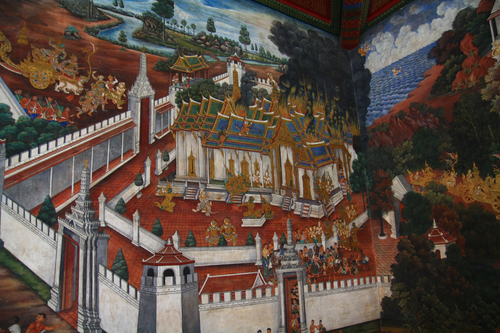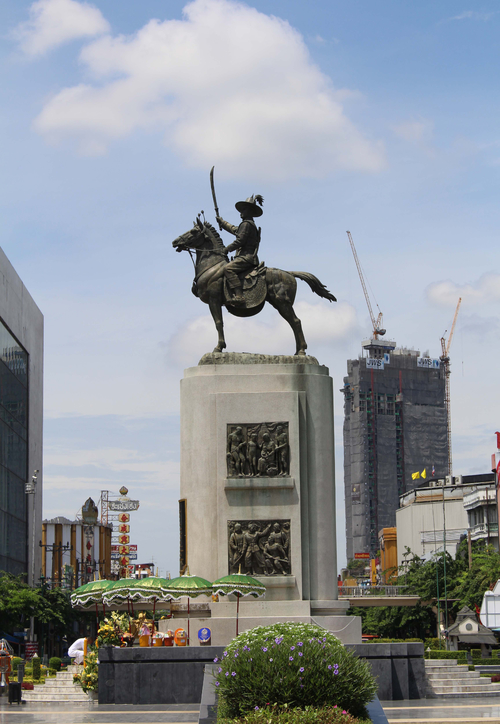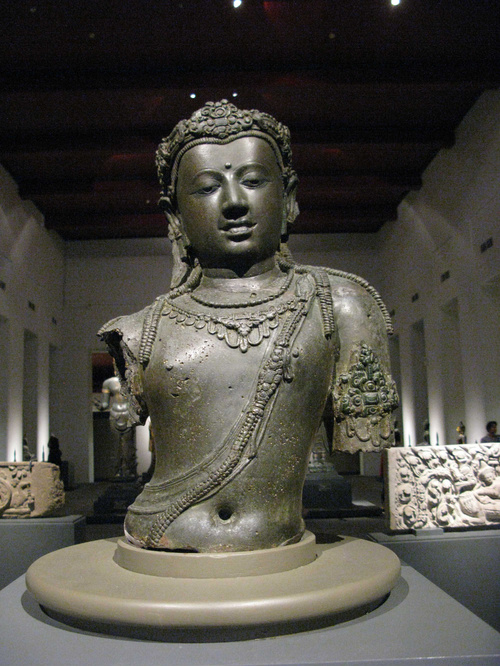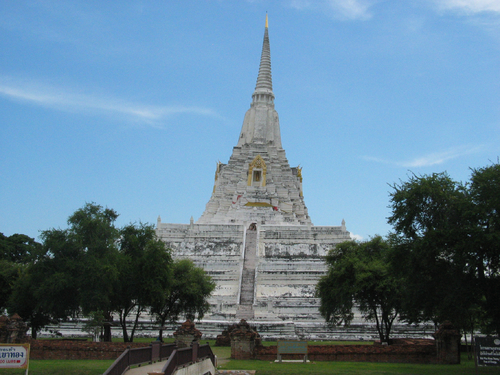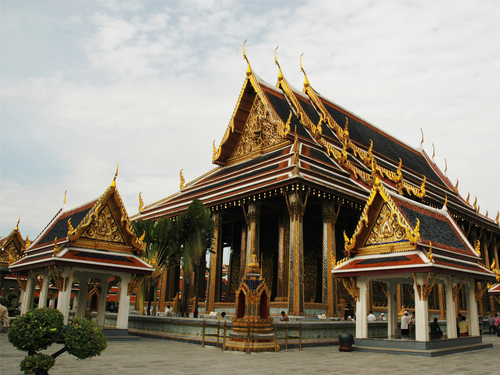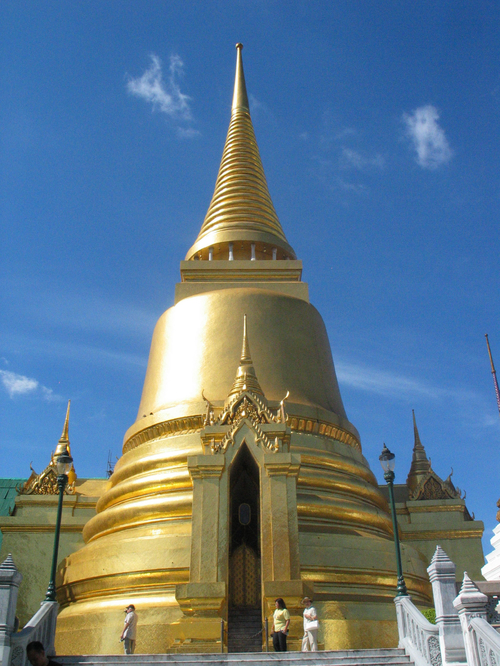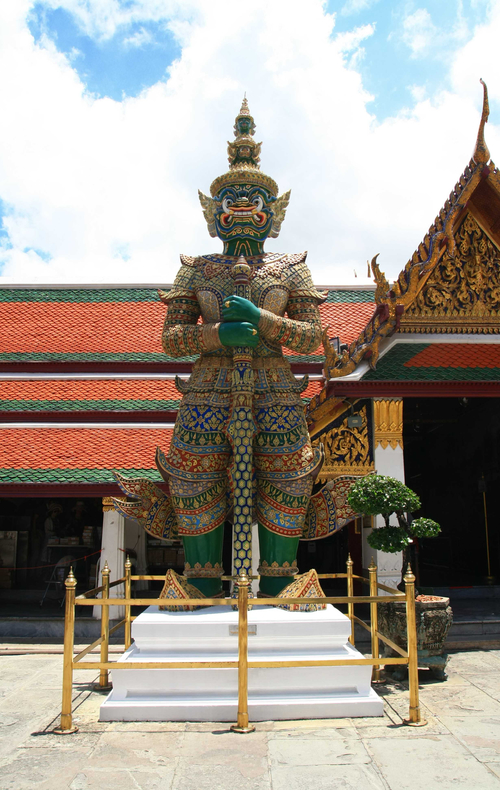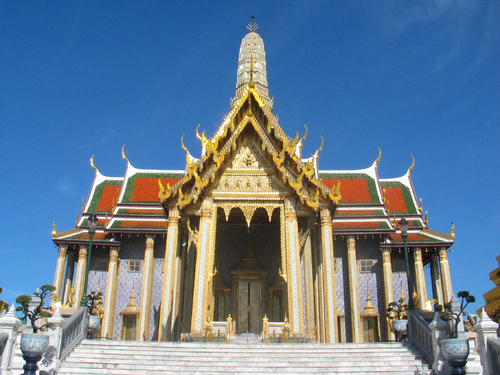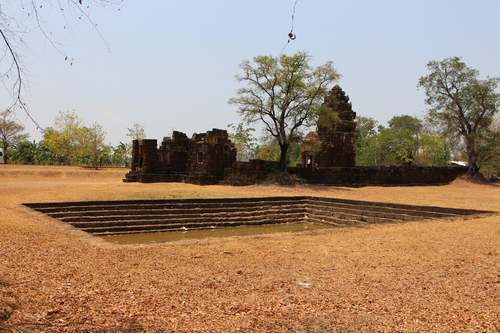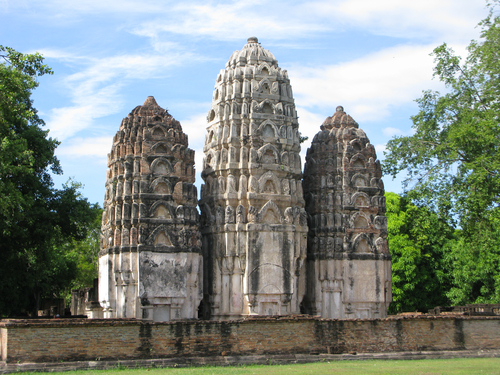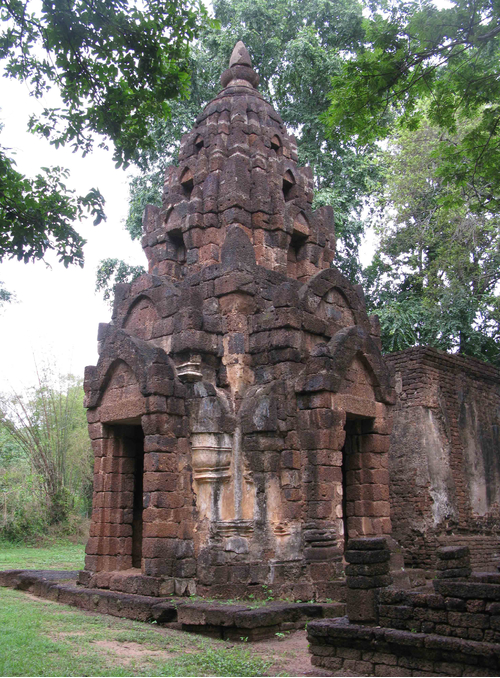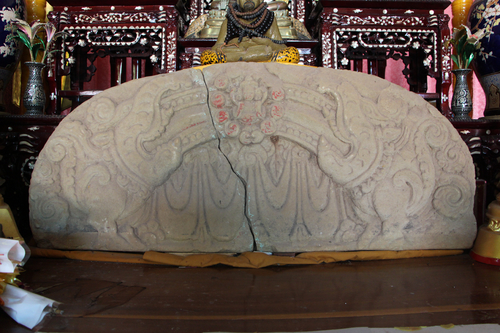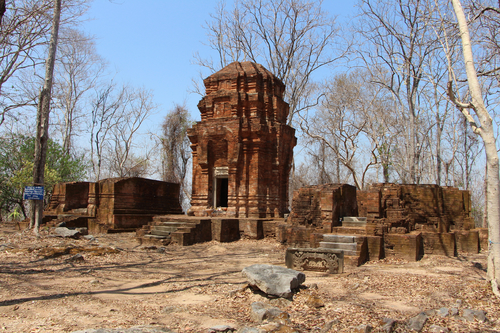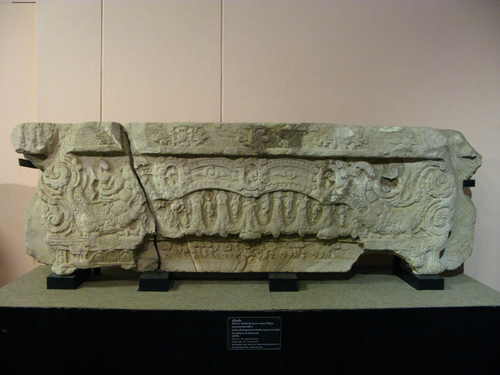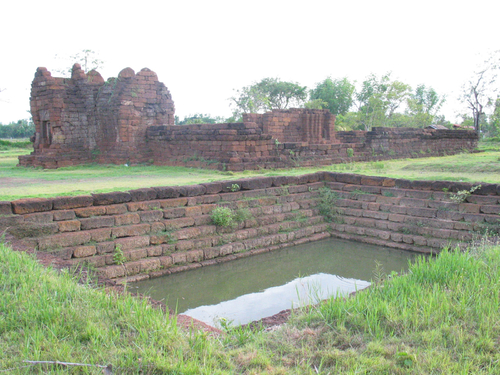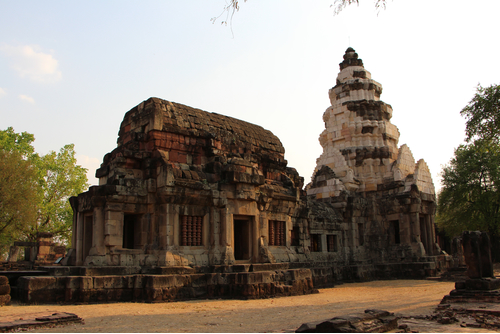Arts in Southeast Asia
ฐานข้อมูลศิลปกรรมในเอเชียตะวันออกเฉียงใต้
ศิลปกรรมยอดนิยม
Most Popular
ศิลปกรรมล่าสุด
Latest
หอคอยมัสยิดกำปงกลิง
อาคารมัสยิดแบบเอเชียอาคเนย์ มีลักษณะแตกต่างไปจากแบบอินเดียหรือเปอร์เซียมาก คืออยู่ในผังสี่เหลี่ยมจัตุรัส ภายในมีเสาสี่ต้นรองรับหลังคาลาดจำนวนมากซึ่งเป็นเครื่องไม้มุงกระเบื้อง ไม่มีโดม ที่น่าสนใจอีกประการหนึ่งก็คือหอคอยซึ่งมีเรือนธาตุซ้อนขึ้นไปเป็นชั้นๆและจบด้วยหลังคาลาดแบบจีน การซ้อนชั้นของหอคอยดังกล่าวคล้ายคลึงอย่างยิ่งกับเจดีย์ (ถะ) ในศิลปะจีน ในขณะเดียวกันก็คล้ายคลึงกับหอคอยตามแบบดาร์คารห์ (Dargarh) ของนาคปัฏฏนัมในอินเดียใต้ด้วย
อาณานิคมดัตช์
พุทธศตวรรษที่ 22-23
สถาปัตยกรรม
สถาปัตยกรรมกุฏิฤาษีบ้านโคกเมือง
แผนผังรูปสี่เหลี่ยมผืนผ้า ด้านนอกสุดเป็นกำแพงศิลาแลงมีซุ้มประตูทางเข้าหรือโคปุระทางทิศตะวันออก ตรงกลางภายในเป็นที่ตั้งของปราสาทประธานก่อด้วยศิลาแลง บางตอนมีหินทรายประกอบกรอบประตู ประตูด้านหน้าทางทิศตะวันออกทำเป็นมุขยื่นออกมา ประตูอีก 3 ด้านเป็นประตูหลอก ส่วนทางด้านทิศตะวันออกเฉียงใต้ของปราสาทประธานภายในกำแพงแก้วเป็นบรรณาลัยก่อด้วยศิลาแลงเช่นเดียวกัน บางส่วนของโคปุระและปราสาทประธานมีการประดับด้วยส่วนประกอบของหน้าบันหรือทับหลังเป็นรูปนาค มกรคายนาค สันนิษฐานว่าเป็นรูปแบบศิลปะในราวพุทธศตวรรษที่ 16-17 แต่ทว่าส่วนประดับเหล่านี้ดูไม่สู้จะต่อเนื่องกับปราสาทประธานและกำแพง จึงอาจเป็นการนำของเดิมมาประกอบอาคารที่ก่อสร้างใหม่ อย่างไรก็ตาม หากชิ้นส่วนประดับสถาปัตยกรรมเหล่านี้เป็นของที่มีมาแต่เดิม ก็อาจสันนิษฐานว่าเคยมีศาสนสถานแห่งหนึ่งสร้างขึ้นในราวพุทธศตวรรษที่ 16 ต่อมาในพุทธศตวรรษที่ 18 จึงปรับเปลี่ยนใช้เป็นอโรคยศาลในพุทธศาสนามหายาน
สถาปัตยกรรมวัดศรีสวาย
ตั้งหันหน้าไปทางทิศใต้ มีกำแพงศิลาแลงล้อมรอบเป็นรูปสี่เหลี่ยมผืนผ้า กึ่งกลางกำแพงด้านทิศใต้มีซุ้มประตูเข้าออก 1 แห่ง ถัดเข้าไปเป็นวิหารโถงชั้นนอกต่อเนื่องด้วยวิหารทึบชั้นในในแนนวเหนือใต้ ถัดจากนั้นเป็นปราสาท 3 หลังเรียงกันในแนวตะวันตก-ตะวันออก หลังกลางสูงกว่าหลังที่ขนาบทั้งสองข้าง สภาพปัจจุบันแสดงให้เห็นร่องรอยการก่อสร้างและดัดแปลงมาแล้วหลายครั้ง ส่วนฐานนั้นจมดินอยู่ ก่อด้วยศิลาแลงมาจนถึงเรือนธาตุ แต่ส่วนหลังคาที่ซ้อนเป็นชั้นก่อด้วยอิฐ ประดับกลีบขนุนรูปครุฑยุดนาค เทวดา อัปสร นาคโคนกรอบซุ้ม ซึ่งคลี่คลายจากศิลปะเขมรผสมผสากับศิลปะสุโขทัย นอกจากนี้ยังมีร่องรอยสิ่งก่อสร้างอื่นๆ ได้แก่ แนวระเบียงล้อมรอบปราสาท ฐานอาคาร 3 หลังกระจายล้อมรอบปราสาทประธานพื้นที่ระหว่างกำแพงวัดและกำแพงแก้วมีสระน้ำอยู่ด้านหลังปราสาท ซึ่งในอดีตน่าจะเป็นรูปตัว U คว่ำ ต่อมาได้มีการถมบริเวณทิศตะวันตกและปรากฏวิหารน้อยก่อด้วยศิลาแลง 1 หลัง ด้านหน้าวิหารน้อยปรากฏฐานเจดีย์ 1 องค์ ส่วนด้านหลังกำแพงวัดด้านทิศเหนือยังปรากฏฐานอาคารก่อด้วยศิลาแลง 1 หลัง โบราณวัตถุชิ้นสำคัญที่ค้นพบได้ในวัด ได้แก่ ทับหลังนารายณ์บรรทมสินธุ์ แผ่นหินสลักรูปพระนารายณ์ประทับยืน พระพุทธรูปสำริดทรงเครื่อง กำหนดอายุในราวพุทธศตวรรษที่ 18 จึงสันนิษฐานว่าเมื่อแรกสร้างวัดศรีสวายนี้เพื่อเป็นศาสนสถานในศาสนาพราหมณ์หรือพุทธมหายาน ต่อมาเมื่อสุโขทัยมีอำนาจเหนือขอมในพุทธศตวรรษที่ 19 จึงได้มีการปรับเปลี่ยนเป็นศาสนสถานพุทธเถรวาท
สถาปัตยกรรมปราสาทวัดเจ้าจันทร์
ประกอบด้วยปราสาทประธานก่อด้วยศิลาแลง มีแผนผังรูปสี่เหลี่ยมจัตุรัสออกมุม และมีปูนฉาบประดับตกแต่งผิว ฐานชั้นล่างสุดเป็นชุดบัวคว่ำ-บัวหงาย ที่เรือนธาตุมีซุ้มประกอบทั้งสี่ด้าน มีประตูทางเข้าด้านหน้าทางทิศตะวันออกเพียงทางเดียวด้านหน้ามีห้องสำหรับประดิษฐานรูปเคารพ ส่วนด้านอื่นๆ ตกแต่งเป็นประตูหลอก ถัดขึ้นไปเป็นชุดเครื่องบนของปราสาทสอบคล้ายรูปพุ่มและมีกลศประดับเป็นเครื่องยอด ต่อมาในสมัยสุโขทัย ศาสนสถานแห่งนี้ได้รับการปรับเปลี่ยนให้เป็นวัดทางพระพุทธศาสนา โดยการถมบริเวณโดยรอบของฐานปราสาท ทำให้ฐานชุดบัวคว่ำ-บัวหงายจมอยู่ใต้ดิน แล้วจึงสร้างวิหารศิลาแลงขึ้นที่ด้านหน้าของปรางค์ปราสาทพร้อมกับมณฑปศิลาแลงสำหรับประดิษฐานพระอัฏฐารศขึ้นทางทิศเหนือของปรางค์ ในมณฑปมีโกลนศิลาแลงพระพุทธรูปยืนพระหัตถ์แนบลำพระองค์ ๑ องค์ หลังคาที่เป็นเครื่องไม้ได้ผุพังไป พบเพียงชิ้นส่วนของกระเบื้องดินเผาสำหรับมุงหลังคาตกกระจายอยู่โดยรอบ ต่อมากรมศิลปากรได้ขุดพบพระพิมพ์ทำด้วยชิน ทรงเครื่องแบบกษัตริย์ และเมื่อขุดลึกลงไปอีกในระดับลึกพบโบราณวัตถุสมัยทวารวดี เครื่องถ้วยหริภุญไชย ลูกปัดแก้ว และชิ้นส่วนโครงกระดูกคน
ประติมากรรมทับหลังแบบถาลาบริวัต
ทับหลังมีสภาพชำรุดแตกหักออกเป็นสองชิ้น ที่ขอบด้านข้างทั้งสองแกะสลักเป็นรูปมกรหันหน้าเข้าหากันแล้วคายวงโค้งที่ประกอบด้วยวงโค้งด้านละหนึ่งวง ภายในวงโค้งนั้นเรียบไม่มีลวดลายมาประดับ ส่วนขอบวงโค้งทั้งด้านบนและล่างประดับแนวลูกประคำ ภายใต้วงโค้งเป็นลายพวงอุบะที่มีช่อกลางใหญ่ที่สุดห้อยสลับกับลายพวงมาลัยที่มีลายใบไม้สามเหลี่ยมอยู่ภายใน บริเวณที่วงโค้งแต่ละข้างมาบรรจบกัน ปรากฏรูปครุฑยุดนาคอยู่ภายในวงกลมรูปเหรียญ ครุฑนั้นมีหน้าเป็นมนุษย์ และปรากฏเฉพาะใบหน้าและลำตัวเท่านั้น
สถาปัตยกรรมปราสาทเขาน้อย
ผังของปราสาทเขาน้อยประกอบไปด้วยอาคาร 3 หลังตั้งอยู่ในแนวเหนือใต้ ซึ่งหลังเหนือและใต้พังทลายลงเหลือเพียงหลังกลาง ปราสาททิศเหนือและปราสาทหลังกลางตั้งอยู่บนฐานอันเดียวกัน แต่ปราสาททิศเหนือสร้างยื่นล้ำออกมาข้างนอกมาก ส่วนอาคารทิศใต้ตั้งอยู่บนฐานสูงเท่ากันแต่แยกห่างออกไปเล็กน้อย มีเพียงแนวฐานอิฐด้านหลังทำมาเชื่อมต่อกัน ซึ่งก็จะเห็นได้ว่าการวางผังก่อสร้างอาคารทั้ง 3 หลังนี้ไม่ได้สร้างให้อยู่ในแนวเดียวกัน เป็นลักษณะที่คล้ายกับการสร้างปราสาทในสมัยก่อนเมืองพระนครของเขมรซึ่งไม่ค่อยมีระเบียบนักปราสาทด้านทิศเหนือมีผังรูปสี่เหลี่ยมผืนผ้า มีทางเข้าด้านทิศตะวันออก อีก 3 ด้านเป็นประตูหลอก ช่องทางเข้าสร้างให้ยืดยาวออกไป ทำให้ผังของอาคารด้านนี้มีลักษณะเป็นช่องลึก ผังในห้องเป็นรูปสี่เหลี่ยมผืนผ้า แต่ละด้านทำเป็นช่องเว้าเข้าไปปราสาทหลังกลางเป็นอาคารก่ออิฐไม่สอปูนในผังสี่เหลี่ยมเพิ่มมุมไม้สิบสอง มีทางเข้าทางทิศตะวันออกทางเดียว อีก 3 ด้านเป็นประตูหลอก ส่วนด้านในเป็นห้องที่มีความยาวแต่ละด้านไม่เท่ากัน ส่วนทิศใต้เป็นอาคารรูปสี่เหลี่ยมผืนผ้าบนฐานอิฐ ผังอาคารก่อสร้างเป็นผนังขึ้นไป ทางเข้าทางทิศตะวันออกทำเป็นมุขยื่นออกมา ผังในอาคารก็เป็นรูปสี่เหลี่ยมผืนผ้าเช่นเดียวกัน
ประติมากรรมทับหลังจากปราสาทเขาน้อยหลังกลาง
การสลักเป็นรูปมกรสองตัวที่ปลายขอบทั้งสองข้างหันหน้าเข้าภายในคายวงโค้งออกมาสี่วง เหมือมกรมีรูปบุคคลขี่เบื้องบนกับเบื้องล่างของมกรมีฐานมารองรับ บริเวณกึ่งกลางและที่เสี้ยวที่ลายวงโค้งมาบรรจบกันปรากฏลายวงรูปไข่หรือวงรูปเหรียญสามวง ที่ขอบวงโค้งทั้งสี่วงมีลายประคำประดับอยู่โดยรอบ ส่วนที่ขอบของลายวงรูปเหรียญมีทั้งลายลูกประคำและลายใบไม้ม้วนประกอบอยู่ ภายในวงรูปเหรียญมีรูปเทวดาทรงพาหนะวงละหนึ่งองค์ ในขณะที่ภายในลายวงโค้งสองวงกลางมีลายดอกไม้สี่กลีบประดับอยู่ เหนือลายวงโค้งมีลายใบไม้ตั้งขึ้น ส่วนเบื้องล่างของลายวงโค้งสลักเป็นลายพวงมาลัยสลับกับพวงอุบะ ภายในลายพวงมาลัยมีลายใบไม้แหลมหยักอยู่พวงละหนึ่งใบ ส่วนพวงอุบะล้วนมีขนาดเท่ากันหมดทุกพวง รายละเอียดที่กล่าวมานี้สามารถเปรียบเทียบได้จากทับหลังปราสาทสมโบร์ไพรกุกหมู่ใต้ หลังที่ 7
สถาปัตยกรรมปราสาทกู่พันนา
ประกอบด้วยปราสาทประธานทรงสี่เหลี่ยมจัตุรัสย่อมุมหนึ่งหลัง ตั้งอยู่กึ่งกลางภายในกำแพงศิลาแลงในผังสี่เหลี่ยมผืนผ้า เครื่องบนของปราสาทประธานนั้นพังทลายลงไป ส่วนประตูทางเข้าออกนั้นด้านเดียวทางทิศตะวันออก ส่วนอีก 3 ด้านทำเป็นประตูหลอก ประตูทางเข้าออกนี้ทำเป็นห้องยาวๆ ด้านหน้าเป็นมุข ส่วนทางทิศตะวันออกเฉียงใต้ของปราสาทประธานปรากฏเฉพาะส่วนฐานของบรรณาลัยสร้างด้วยศิลาแลงในผังเป็นรูปสี่เหลี่ยมผืนผ้า ส่วนกึ่งกลางของกำแพงศิลาแลงด้านทิศตะวันออกนั้นปรากฏซุ้มประตูหรือโคปุระในผังจัตุรัสรูปกากบาท และภายนอกกำแพงทางทิศตะวันออกเฉียงเหนือนั้นมีสระน้ำรูปทรงสี่เหลี่ยมผืนผ้าก่อด้วยศิลาแลงเช่นเดียวกัน
สถาปัตยกรรมปราสาทพนมวัน
อยู่ในแผนผังสี่เหลี่ยมจัตุรัสหันหน้าไปทางทิศตะวันออก กลุ่มปราสาทประธานประกอบด้วยตัวปราสาทประธาน อันตราละ และมณฑปตั้งอยู่บนฐานเดียวกันปราสาทประธานมีแผนผังเป็นรูปสี่เหลี่ยมจัตุรัสออกมุม มีซุ้มมุขและประตูทางเข้าทั้งสี่ทิศ โดยมีมุขทางเข้าด้านทิศตะวันออกเชื่อมต่อกับอันตราละคือฉนวนหรือมุขกระสันซึ่งทำเป็นทางผ่านไปยังมณฑปที่อยู่ทางด้านหน้า มณฑปนั้นมีแผนผังเป็นรูปสี่เหลี่ยมผืนผ้า มีประตูทางเข้าทั้งสี่ทิศเช่นเดียวกับปราสาทประธาน และมีหลังคาเป็นรูปโค้งทรงประทุน ทั้งหมดนี้ล้อมรอบด้วยแนวระเบียงคดซึ่งมีโคปุระหรือซุ้มประตูอยู่ทั้ง 4 ทิศ แต่ละมุมทั้ง 4 ของระเบียงคดยังปรากฏซุ้มทิศขนาดเล็กทรงสี่เหลี่ยมออกมุมมีประตูทางเข้าและประตูที่เชื่อมต่อกับปีกโคปุระทั้ง 2 ด้านส่วนทางทิศใต้ของปราสาทประธานในเขตระเบียงคดมีปราสาทขนาดย่อมลงมาเรียกกันว่าปรางค์น้อย มีผังแบบเพิ่มมุม ส่วนฐานก่อด้วยศิลาแลง แต่ส่วนของเรือนธาตุก่อด้วยหินทราย มีประตูทางเข้าออกทางทิศตะวันออกเพียงด้านเดียว ด้านที่เหลือเป็นประตูหลอก ปัจจุบันส่วนยอดได้พังทลายลงมาแล้ว องค์ปราสาทยังไม่มีการสลักลวดลายตกแต่งลงไปเป็นเพียงโครงสร้างรูปปราสาทเท่านั้น จากลักษณะดังกล่าวข้างต้นสันนิษฐานว่าปรางค์น้อยนี้น่าจะมีอายุอยู่ในช่วงพุทธศตวรรษที่ 16 เป็นต้นมา ภายในยังเป็นที่ประดิษฐานรอยพระพุทธบาทหินทราย นอกจากนี้ภายในระเบียงคดยังพบแนวฐานอาคารอิฐหลายหลังอยู่ล้อมรอบปราสาทประธานอีกด้วย



